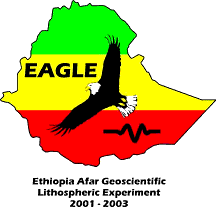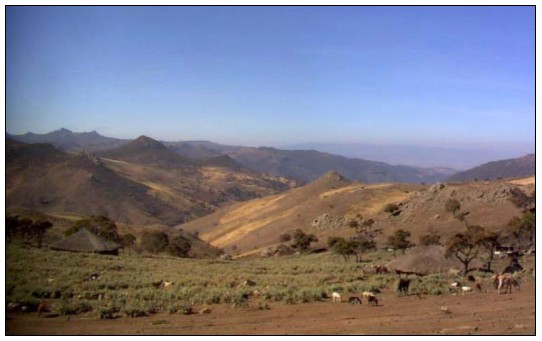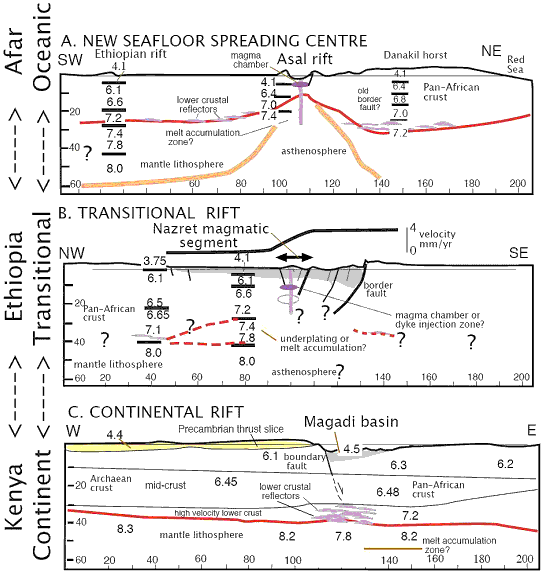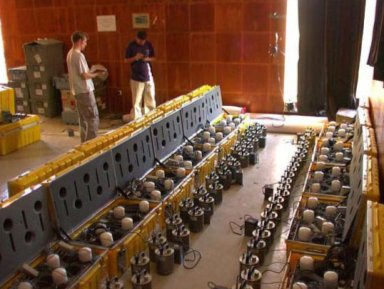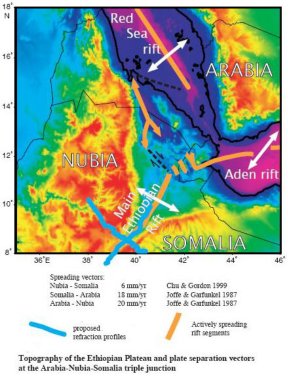[an error occurred while processing this directive]
[an error occurred while processing this directive]
Updated: Dec 09, 2024
IGCP Project 559 - Seismic Images
Crustal Architecture of the East African Rift System
A review compiled by doug.finlayson@netspeed.com.au
Kenya Rift International Seismic Project (KRISP)
Background
The East African Rift is the largest continental rift system on Earth. It extends from Lebanon in the north, along the Red Sea and through Sudan, Ethiopia, Kenya, Tanzania to Mozambique. A number of web sites with articles/papers/information on the rift are presented in: http://www.geolor.com/East_African_Rift_Valley_geolor.htm
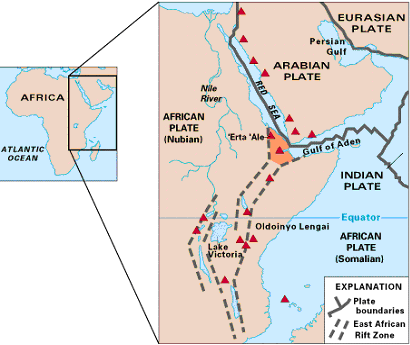
Figure 1 – Map of East Africa showing some of the historically active volcanoes (red triangles)
and the Afar Triangle (shaded, centre) — a so-called triple junction (or triple point),
where three plates are pulling away from one another: the Arabian Plate, and the two parts
of the African Plate (the Nubian and the Somalian) splitting along the East African Rift Zone.
(US Geological Survey) http://pubs.usgs.gov/gip/dynamic/dynamic.html
Most of the seismic investigations of crustal structure within the rift system to date have involved wide-angle seismic profiling with shot-to-recorder offsets of more than 400-700 km in places.
EAGLE (Ethiopia-Afar Geoscientific Lithospheric Experiment):
An investigation to examine the issues surrounding modification of lithospheric structure during continental break-up
Situated where the southern Red Sea and the Gulf of Aden meet the East African Rift, Ethiopia is one of the very few places on Earth where geologists can study the active process of stretching of the continental plate and associated volcanism and tectonic activity, prior to flooding by a newly formed sea.
The EAGLE field work is focussed on the Ethiopia-Red Sea-Gulf of Aden region.
http://pangea.stanford.edu/~sklemp/EAGLEtext56.html
http://www.le.ac.uk/press/ebulletin/features/eaglespreads.html
http://prodev.iris.edu/OnePagers/klemperer2.pdf
http://talisker.geol.le.ac.uk/~amb27/website/eagle_phase3_field_rep_2003.pdf
Some of the questions being asked are:
- What is crustal structure associated with individual magmatic rift segments? That is, what volume of magmatic material has been added to the crust across the rift? How is crustal structure modified by faulting and magmatic processes? Are there pre-rift variations in crustal composition and/or lithospheric properties across the continental rift that influence the location of the magmatic segments and border faults?
- Does the spatial distribution of Quaternary magmatism correlate with the distribution of long-term and present-day strain?
- Is there asthenospheric upwelling beneath the Quaternary magmatic segments? That is, can we determine whether the pattern of mantle flow is related to lateral movement of plume material from a plume stem (e.g. Ebinger & Sleep 1998), or discrete mantle upwellings, as along mid-ocean ridges
Answers to Questions 1-3 above will allow us to distinguish between models of continental break-up, resolving, at least for the Main Ethiopian Rift, the controversy: Do border faults serve as incipient lithospheric-scale detachments or do asthenospheric upwellings supply magma to crustal reservoirs, enabling strain accommodation by diking similar to oceanic rifts?
Shaded regions (in image above) are anomalously low-velocity zones interpreted as melt accumulations. B) corresponds to the proposed study area: deep structure is highly conjectural.
- ew seafloor spreading centre, the Asal rift;
- transitional rift segment: the Wonji basin and Nazret magmatic segment. Bold line shows extensional velocity profile across the rift, with the strain accommodated across the neovolcanic zone.
- continental rift, the Magadi basin, Kenya.
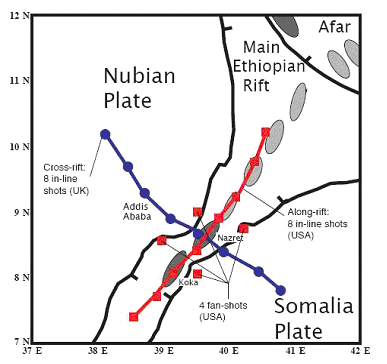
Proposed wide-angle seismic profiling lines,
Ethiopian region of the East African Rift.
Structure and Evolution of the Main Ethiopian Rift
Simon Klemperer – Stanford University
G. Randy Keller – University of Texas at El Paso
Kevin Mickus – Southwest Missouri State University
Tanya Furman – Pennsylvania State University
http://prodev.iris.edu/OnePagers/klemperer2.pdf
The Ethiopia Afar Geoscientific Lithospheric Experiment (EAGLE) was undertaken in 2003 by an international team composed primarily of U.S., British and Ethiopian scientists and students to provide a snapshot of lithospheric breakup at the transition between continental and oceanic rifting. Our focus is the Main Ethiopian Rift (MER) that extends from central Ethiopia into Afar towards the Gulf of Aden and Red Sea oceanic rifts. The MER cuts across the uplifted Ethiopian plateau, which is a major Oligocene flood basalt province associated with the impact of the Afar mantle plume.

Horizontal slice through the 3-D tomographic model at 10 km below the surface
(after Keranen et al., 2004). EAGLE Lines 1 & 2 dashed.
High-velocity bodies (red) interpreted as solidified magmatic intrusions beneath the rift floor.
Diamonds identify volcanoes: Al - Aluto, B - Boset, D - Dofan, F - Fantale, G - Gademsa,
H - Hertale, K - Kone, LHF - Liado Hayk Field, TM - Tullu Moje, Sh - Shala, Y - Yerer, Z - Zikwala
Keranen, K., Klemperer, S.L., Gloaguen, R. & the EAGLE Working Group, Imaging a protoridge axis in the Main Ethiopian Rift, Geology, 32(11), 949 – 952, 2004.
Maguire, P., Ebinger, C., Stuart, G., Mackenzie, G., Whaler, K., Kendall, J.-M., Khan, M., Fowler, C., Klemperer, S., Keller, G., Harder, S., Furman, T., Mickus, K., Asfaw, L., Ayele, A.,& Abebe, B., Geophysics project in Ethiopia studies continental breakup. EOS (Transactions American Geophysical Union), 84(35), 342-343, 2003.
Seismicity of the northern Main Ethiopian rift
D.Keir(1), C.Ebinger(1), G.Stuart(2), E.Daly(3), A.Ayele(4)
- Geology Department, Royal Holloway University of London, UK. Email: d.keir@gl.rhul.ac.uk
- School of Earth Sciences, University of Leeds, UK.
- National University of Ireland, Galway, Ireland.
- Geophysical Observatory, Addis Ababa University, Ethiopia.
See also:
Keir, D; Ebinger, CJ; Stuart, GW; Daly, E; Ayele, A (2006) Strain accommodation by magmatism and faulting as rifting proceeds to breakup: Seismicity of the northern Ethiopian rift, J GEOPHYS RES-SOL EA, 111(B5), . doi:10.1029/2005JB003748
and
Daly, E; Keir, D; Ebinger, CJ; Stuart, GW; Bastow, ID; Ayele, A (2008) Crustal tomographic imaging of a transitional continental rift: the Ethiopian rift, GEOPHYS J INT, 172(3), pp1033-1048. doi:10.1111/j.1365-246X.2007.03682.x
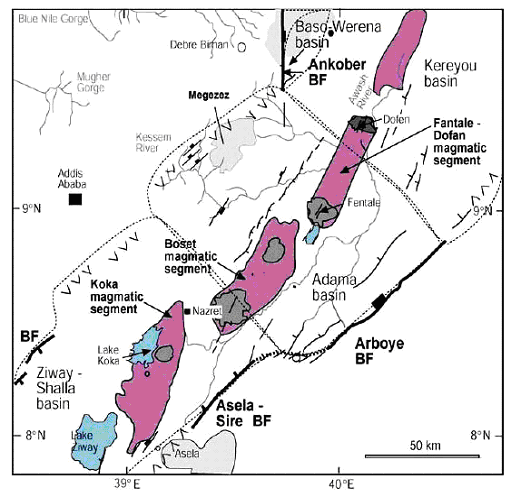
Major faults and magmatic segments of the northern Main Ethiopian rift (Wolfenden et al, 2004).
The northern Main Ethiopian rift (MER) developed within the Paleogene flood basalt province of NE Africa, and forms the youngest arm of the Afar triple junction. High angle, large-offset border faults formed after 12Ma, providing a linkage between the East African rift system and the southern Red Sea-Gulf of Aden rifts (Wolfenden et al, 2004). However, active subsidence migrated to a narrower zone in the central rift by 3.5Ma. Since 1.8Ma magmatism and faulting has become more localized to ~20km-wide, 60km-long 'magmatic segments' marked by aligned eruptive centers, fissures, and small offset normal faults. This pattern of faulting and magmatism indicates that the East African rift system in Ethiopia is in a stage of development that is transitional between continental and oceanic in style (Ebinger & Casey, 2001)
Ebinger, C.J., Casey, M. Continental breakup in magmatic provinces: An Ethiopian example. Geology, v.20, no. 6, p. 527-530. 2001.
Maguire, P., and 15 others. Geophysical project in Ethiopia studies continental Breakup. Eos, Transactions of the American Geophysical Union, v. 84, p. 337, 342-343, 2003.
Waldhauser, F. & Ellsworth, W.L. A double-difference earthquake location algorithm: Method and application to the northern Hayward fault. Bull. Seismol. Soc. Am., v.90, p.1353 – 1368, 2000.
Wolfenden, E., C. Ebinger, G. Yirgu, A. Deino, D. Ayalew. 2004. Evolution of the northern Main Ethiopian rift: Birth of a triple junction, Earth Planet. Sci. Letts., 2004.
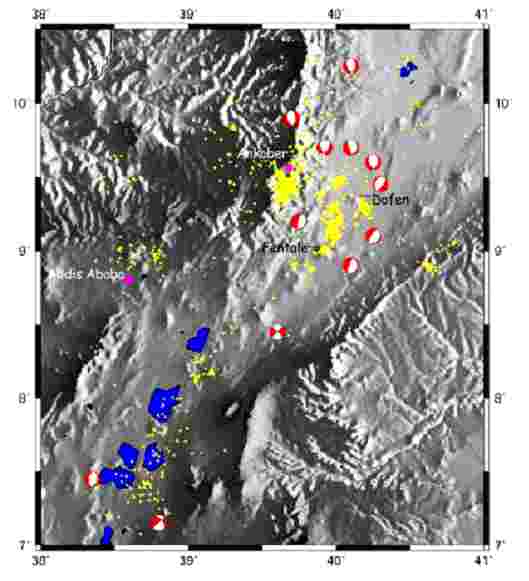
Seismicity of the EAGLE project study area October 2001 – January 2003.
Yellow dots are earthquake epicenters located using 4 or more stations and having
a RMS travel time residual of less than 0.5s.
First motion fault plane solutions are calculated
from at least 10 P-wave first motion observations.
Selected bibliography
Abbate, E., Passerini, P. and Zan, I., 1995. Strike-slip faults in a rift area - a transect in the Afar triangle, East-Africa. Tectonophysics, 241: 67-84
Baker B.H., Mohr, P.A., and Williams, L.A.J., 1972. Geology of the East Africa rift system, Geol. Soc. America Spec. Paper, 136, 67 pp.
Beydoun, Z.R., 1996. Rift sedimentation and tectonics in the Red Sea and Gulf of Aden region. Journal of Petroleum Geology, 19: 235-245.
Birt, C., Maguire, P., Khan, M., Thybo, H., Keller, G. & Patel, J., 1997. The influence of pre-existing structures of the southern Kenya rift valley: evidence from seismic and gravity studies, Tectonophyics, 278, 211-242.
Bosworth, W. and Maurin, A., 1993. Structure, geochronology and tectonic significance of the Northern Suguta Valley (Gregory rift), Kenya. Journal of the Geological Society, London, 150: 751-762.
Bosworth, W., 1994. A model for the 3-dimensional evolution of continental rift basins, northeast Africa. Geologische Rundschau, 83(4): 671-688.
Braile, L.W., Wang, B., Daudt, C.R., Keller, G.R., and Patel, J.P., 1994. Modelling the 2-D seismic velocity structure across the Kenya rift. In: C. Prodehl, G.R. Keller, and M.A. Khan (Editors), Crustal and upper mantle structure of the Kenya rift. Tectonophysics, 236: 251-269.
Chorowicz, J., Collet, B., Bonavia, F.F. and Korme, T., 1994. Northwest to north-northwest extension direction in the Ethiopian rift deduced from the orientation of extension structures and fault-slip analysis. Geological Society of America Bulletin, 106(12): 1560-1570.
Ebinger, C.J., 1989. Tectonic development and the western branch of the East African rift system. Geol. Soc. of Am. Bull., 101, 885-903.
Ebinger and Casey, 2001. Continental break-up in magmatic provinces: an Ethiopian example. Geology, 29, 527-530.
Ebinger C.J. and Ibrahim A., 1994. Multiple episodes of rifting in Central and East Africa: A re-evaluation of gravity data. Geol. Rundsch. 83, 689-702.
Ebinger, C. and Sleep, N., 1998. Cenozoic magmatism throughout E Africa resulting from impact of a single plume. Nature, 395, 788-791.
Ebinger, C.J. 1989. Geometric and kinematic development of border faults and accommodation zones, Kivu-Rusizi rift, Africa, Tectonics, 8, 117-133.
Ebinger, C., T. Yemane, D. Harding, S. Tesfaye, D. Rex, S. Kelley, Rift deflection, migration, and propagation: Linkage of the Ethiopian and Eastern rifts, Africa, Geol. Soc. Amer. Bull., 102, 163-176, 2000.
Foster, A., Ebinger, C., Mbede, E. and Rex, D., 1997. Tectonic development of the northern Tanzanian sector of the East-african rift system. Journal of the Geological Society, London, 154: 689-700.
Hay, D.E., R.F. Wendlandt, and G.R. Keller, 1995, The origin of Kenya rift Plateau-type flood phonolites: Integrated petrologic and geophysical constraints on the evolution of the crust and upper mantle beneath the Kenya rift: Journal of Geophysical Research, 100, 10,549-10,557.
Jestin, F., Huchon, P. and Gaulier, J.M., 1994. The Somalia plate and the East-African rift system - present-day Kinematics. Geophysical Journal International, 116(3): 637-654.
Keller, G.R., Mechie, J., Braile, L.W., Mooney, W.D. and Prodehl, C., 1994. Seismic structure of the uppermost mantle beneath the Kenya Rift. In: C. Prodehl, G.R. Keller and M.A. Khan (Editors), Crustal and upper mantle structure of the Kenya rift. Tectonophysics, 236: 201-216.
Keller, G. R., C. Prodehl, J. Mechie, K. Fuchs, M. A. Khan, P. K. H Maguire, W. D. Mooney, U. Achauer, P. M. Davis, R. P. Meyer, L. W. Braile, I. O. Nyambok, & G. A. Thompson, 1994. The East African rift system in the light of KRISP 90. In Crustal and Upper Mantle Structure of the Kenya Rift, C. Prodehl, G. R. Keller and M. A. Khan (eds.), Tectonophysics, v. 236, p. 465-483.
Makris, J., Menzel, H., Miller, H. & Vees, R. 1975. Deep seismic soundings in the Afar region and on the highland of Ethiopia, in Afar Between Continental and Oceanic Rifting, edited by A. Pilger and A. Rösler, Schweizerbart, Stuttgart, pp.89-107. Smith, M. and Mosley, P., 1993. Crustal heterogeneity and basement influence on the development of the Kenya rift, East-Africa. Tectonics, 12: 791-.
Mechie, J., Keller, G.R., Prodehl, C., Gaciri, S., Braile, L.W., Mooney, W.D., Gajewski, D. and Sandmeier, K.-J., 1994. Crustal structure beneath the Kenya Rift from axial profile data. In: C. Prodehl, G.R. Keller and M.A. Khan (Editors), Crustal and upper mantle structure of the Kenya rift. Tectonophysics, 236: 179-200.
Mohr, P., 1992. Nature of the crust beneath magmatically active continental rifts. Tectonophysics, 213: 269-284.
Morley, C.K., Wescott, W.A., Stone, D.M., Harper, R.M., Wigger, S.T., and Karanja, F.M., 1992. Tectonic evolution of the northern Kenyan rift. J. Geol. Soc. Lond., 149: 333-348.
Prodehl, C., and Mechie, J., 1991. Crustal thinning in relationship to the evolution of the Afro-Arabian rift system - a review of seismic-refraction data. In: Makris, J., P. Mohr, and R. Rihm, (Editors), Red Sea: Birth and early history of a new oceanic basin.
Prodehl, C., Mechie, J., Achauer, U., Keller, G.R., Khan, M.A., Mooney, W.D., Gaciri, S.J., and Obel, J.D. 1994b. The KRISP 90 seismic experiment – a technical review. Tectonophysics, 236, 33-60.
Simiyu, S. M. and G. R. Keller, 1997, An integrated analysis of lithospheric structure across the East African Plateau based on gravity anomalies and recent seismic studies: Tectonophysics, v. 278, p. 291-313.
Smith, 1994. Stratigraphic and structural constraints on mechanisms of active rifting in the Gregory rift, Kenya. Tectonophysics, 236(1-4): 3-22.
WoldeGabriel, G., Aronson, J. & Walter, R. 1990. Tectonic development of the Main Ethiopian rift, Geol. Soc. Amer. Bull, 102, 439-458.
[an error occurred while processing this directive]

